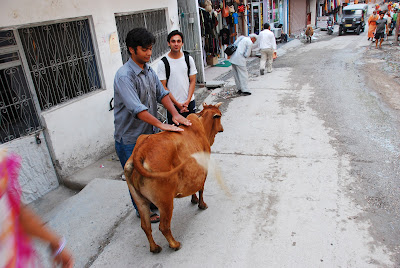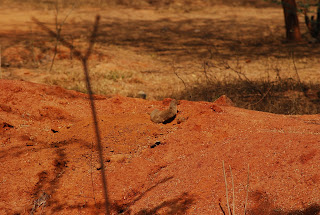It pays to look around when travelling, because the most commonplace routes often conceal a lot that can fascinate, amuse and entertain.
Particularly in India, where 'amusement' can be generated by our healthy (?) disdain for those who do not speak and write our languages the way we do.
So, there are lots of chuckles to be had because of things written on shop boards, on the rear ends of vehicles, inside buses, on walls, buildings and the like.
If you miss these, there will invariably be people on your road who will do things inexplicable, which will leave you either in splits or shocked, or (more likely) have you looking for a quiet place, some distance away from the source, where you can hold your tummy and chuckle to your heart's content.
There are also other little surprises in store. For example, on a trip to Rishikesh, my friends and I were greatly amused by the miniature cows there. Adapted, no doubt, to their environment, they were very obliging when I had to take a picture.
I remember telling you about possessing an unfortunate sense of humour. This picture is one I've always found amusing in a very cute way, because of the cow at complete peace with itself, most likely unaware that there are bigger cousins in the plains. Why should it worry, anyway?
Then there are times when I've met people with worse comic timing than mine. In 2009, on a visit to Jodhpur for a college photography assignment, we visited a Bishnoi village. Fantastic place, beyond doubt, with houses set far apart, surrounded by fields, and blackbucks roaming freely!
Before you ask, it's the same people who raised hell when Salman Khan shot the beautiful antelopes. The Bishnois love all creatures great and small, and do not take well any attempts to harm them.
During an auto ride to the village, the driver looks at our equipment and asks us our names.
"Danish, Ali and Salman," we replied.
"Achcha! Toh aap bhi Salman ho, aur aap bhi shooting karne aaye ho?"
(So, your name is Salman as well, and you've come to 'shoot'?)
Sweet Lord, have mercy on my soul.
It is at times like this when the human soul feels desolate, forsaken, a lone chirpy bird in a world devoid of smiles.
Apologies for the digression, though. Got carried away.
When you travel with photography on your mind, the best images invariably turn up unawares. On the train to Jodhpur from Delhi, there was a rather long unscheduled stop. So i thought I'd take a few pictures.
Not very good, most of them, but then I saw a kid's legs dangling out of a window of the stationary coach. The photograph I got is one of my favourites.
Like I said earlier, though, shop signs and walls are the best for on-the-go entertainment. I regret that I have no pictures yet of the best ones I've seen. For now, I can just upload the lame ones with little grammatical errors and spelling mistakes.
And of course, stuff that makes you wonder.
Whatever a traditional 'Baba' massage may be.
The best, of course, are the ones I will tell you now.
'Latak mat, patakh doongi' on the door of a bus in Lucknow.
'Jatt' in Urdu on the rear number plate of a scooter in Delhi.
'Khadi kya hai soch mein, chadh ja Khurram Bhai ki coach mein' on the rear of a bus near Brijghat in western U.P.
'Fly Army Aviation, Combat Proven, Even Birds Are Jealous' on the rear end of an SUV in Delhi. Never figured out what that meant.
My favourite, though, was something I saw from the window of a bus, about five years ago in Ghaziabad.
There was a wall lined with mirrors, man-high, with the legend: 'Aap jo kar rahe hain, woh duniya dekh sakti hai.'
An effective deterrent, if ever there was one.
Next time, I'll make sure I have pictures.
Particularly in India, where 'amusement' can be generated by our healthy (?) disdain for those who do not speak and write our languages the way we do.
So, there are lots of chuckles to be had because of things written on shop boards, on the rear ends of vehicles, inside buses, on walls, buildings and the like.
If you miss these, there will invariably be people on your road who will do things inexplicable, which will leave you either in splits or shocked, or (more likely) have you looking for a quiet place, some distance away from the source, where you can hold your tummy and chuckle to your heart's content.
There are also other little surprises in store. For example, on a trip to Rishikesh, my friends and I were greatly amused by the miniature cows there. Adapted, no doubt, to their environment, they were very obliging when I had to take a picture.
I remember telling you about possessing an unfortunate sense of humour. This picture is one I've always found amusing in a very cute way, because of the cow at complete peace with itself, most likely unaware that there are bigger cousins in the plains. Why should it worry, anyway?
Then there are times when I've met people with worse comic timing than mine. In 2009, on a visit to Jodhpur for a college photography assignment, we visited a Bishnoi village. Fantastic place, beyond doubt, with houses set far apart, surrounded by fields, and blackbucks roaming freely!
Before you ask, it's the same people who raised hell when Salman Khan shot the beautiful antelopes. The Bishnois love all creatures great and small, and do not take well any attempts to harm them.
During an auto ride to the village, the driver looks at our equipment and asks us our names.
"Danish, Ali and Salman," we replied.
"Achcha! Toh aap bhi Salman ho, aur aap bhi shooting karne aaye ho?"
(So, your name is Salman as well, and you've come to 'shoot'?)
Sweet Lord, have mercy on my soul.
It is at times like this when the human soul feels desolate, forsaken, a lone chirpy bird in a world devoid of smiles.
Apologies for the digression, though. Got carried away.
When you travel with photography on your mind, the best images invariably turn up unawares. On the train to Jodhpur from Delhi, there was a rather long unscheduled stop. So i thought I'd take a few pictures.
Not very good, most of them, but then I saw a kid's legs dangling out of a window of the stationary coach. The photograph I got is one of my favourites.
Like I said earlier, though, shop signs and walls are the best for on-the-go entertainment. I regret that I have no pictures yet of the best ones I've seen. For now, I can just upload the lame ones with little grammatical errors and spelling mistakes.
And of course, stuff that makes you wonder.
Whatever a traditional 'Baba' massage may be.
The best, of course, are the ones I will tell you now.
'Latak mat, patakh doongi' on the door of a bus in Lucknow.
'Jatt' in Urdu on the rear number plate of a scooter in Delhi.
'Khadi kya hai soch mein, chadh ja Khurram Bhai ki coach mein' on the rear of a bus near Brijghat in western U.P.
'Fly Army Aviation, Combat Proven, Even Birds Are Jealous' on the rear end of an SUV in Delhi. Never figured out what that meant.
My favourite, though, was something I saw from the window of a bus, about five years ago in Ghaziabad.
There was a wall lined with mirrors, man-high, with the legend: 'Aap jo kar rahe hain, woh duniya dekh sakti hai.'
An effective deterrent, if ever there was one.
Next time, I'll make sure I have pictures.
.JPG)




.JPG)






